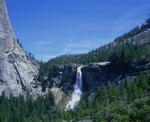White Sands National Monument (NM)
An interagency team of scientists and technical specialists from the NPS, BLM, USGS and DOD joined together last month in an effort to document extremely fragile and ephemeral fossilized footprints with remote imaging technology.
The area of study includes a portion of a Late Pleistocene megatracksite within and around White Sands National Monument. Thousands of “Ice Age” fossil vertebrate tracks and track ways which date to approximately 20,000 years ago have been documented within the White Sands megatracksite.
The trace fossil assemblage is dominated by proboscidean (mammoth) footprints along with associated camelid (camel-like), undetermined artiodactyl, and large and small carnivore tracks. These fossil tracks are preserved in soft gypsiferous lacustrine and playa lake margin sediments which are extremely fragile, ephemeral, and weather rapidly once exposed.
Monitoring of the fossil tracks preserved within the monument continuously reveals new fossil track occurrences, as well as documents the rapid deterioration of previously recorded fossil tracks. Traditional ground level monitoring and photogrammetry (the use of photography to capture high resolution imagery for remote sensing and analysis) of fossil trackways requires close proximity to the fossil tracks by the photographer.
This close proximity typically results in some ground disturbance and leads to the accumulation of modern human footprint impressions in the soft sediments adjacent to the fossil tracks. This potentially leads to overprinting of fossil tracks and damaging some fossil tracks not initially identified by the photographer on the ground.
In an effort to document the large number and diversity of fragile fossil tracks preserved over an extensive geographic area, an interagency team was assembled to support this project. Paleontologists, resource managers and aviation specialists from the NPS, BLM, USGS and the State of New Mexico worked with the staff at White Sands National Monument in a multi-month project planning effort to support the paleontological field work.
The Department of Defense provided high resolution satellite imagery for the area of the monument encompassing the megatracksite and authorized the BLM flight crew to fly an unmanned aircraft system – specifically, an RQ-16 Tarantula-Hawk (T-Hawk) – in the DOD restricted airspace over the park.
This proof of concept project represents the first time a T-Hawk platform has been used to support paleontological research/resource management. The aerial photography and videography enabled centimeter resolution and geospatial data collection while minimizing impacts and ground disturbances to the fragile paleontological resources. Additionally, use of the T-Hawk Platform represented a significant time savings by covering larger geographic areas and reducing the need for in-depth field reconnaissance.
Resource protection is also a consideration as the use of the T-Hawk for aerial photogrammetry enabled data to be captured from the air without threatening the tracks through ground disturbances caused by foot traffic. A strategy of aerial and on-the-ground photogrammetric documentation has proven to be very successful for this project.
In addition to the aerial imagery, six of the most unique and best preserved trackways were identified and photographed using ground base photogrammetric techniques. The ground base photogrammetry collected sub-millimeter data (equivalent to a laser scanning) of the entire trackways. The extreme precision of the ground base photogrammetry will allow the tracks to be studied long after they have weathered away and enable the creation of exact 3-D replica models to be produced for future generations to enjoy and study.
The 3-D models will allow millions to enjoy the tracks virtually or in person with no resource damage, truly leaving no trace and protecting the actual location of sensitive fossil localities. This project provided an excellent opportunity to compare the benefits and limitations of the two methods. The use of photogrammetry will likely yield opportunities for other resource management and interpretation applications, and support long term resource preservation.
Several manuscripts will be developed for publication to describe these important fossil tracks and the technology and methodologies that were used in their documentation. The monument staff is very excited to be able to roll the new findings into comprehensive interpretive planning, development of interpretive media, wayside exhibits, and hands-on activities and 3-D manipulatables.
Interagency Team Documents Ice Age Tracks
All posts are those of the individual authors and the owner
of this site does not endorse them. Content should be considered opinion
and not fact until verified independently.
Sorry, only registered users may post in this forum.


